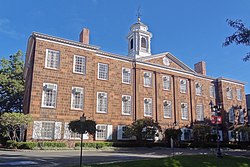As of 2014[update], the State of New Jersey recognizes and licenses 66 institutions of higher education (post-secondary) through its Commission on Higher Education. These institutions include four public research universities, seven state colleges and universities, fourteen private colleges and universities (two of which are classified as research universities), eighteen county colleges, fourteen religious institutions, and eight for-profit proprietary schools.[1]
As of July 2020, The U.S. Department of Education listed 166 colleges and universities in its database. This includes technical and vocational schools that offer only certificates or job training as well as degree-granting colleges and universities.[2]
New Jersey was the only British colony to permit the establishment of two colleges in the colonial period. Princeton University, chartered in 1746 as the College of New Jersey, and Rutgers, The State University of New Jersey, chartered on November 10, 1766, as Queen's College, were two of nine colleges founded before the American Revolution.[3][4][5]: passim. In the 1860s, these two colleges competed to become the state's land grant college under the terms of the Morrill Act of 1862 which provided land and funding to expand development of engineering, scientific, agricultural, and military education at one school in each state. Rutgers received the designation in 1864 began to expand instruction in these areas and taking on a hybrid private-public role that paved the way for its transformation into a state university in 1945. Today, Rutgers is a large public research university serving over 65,000 students. Princeton remained a private college and developed into a research university that is one of the nation's eight prestigious Ivy League schools.
On August 22, 2012, then New Jersey governor Chris Christie signed into law the New Jersey Medical and Health Science Education Restructuring Act which divided the University of Medicine and Dentistry of New Jersey (UMDNJ) between Rutgers and Rowan University, creating two public medical schools.[6][7] According to The Star-Ledger, the law gave Rutgers "nearly all of UMDNJ—including its medical schools in Newark and Piscataway—in one of the greatest expansions in the state university's history" and southern New Jersey's Rowan University would "take over UMDNJ's osteopathic medical school in Stratford."[8]
There are three law schools in the state accredited by the American Bar Association; two at Rutgers (at the university's Rutgers–Newark and Rutgers–Camden campuses respectively) and the other at Seton Hall University's campus in Newark.[9]
- ^ New Jersey Commission on Higher Education. New Jersey College & University Directory by Sector (updated April 1, 2014). Retrieved April 8, 2014.
- ^ "College Navigator". National Center for Education Statistics. July 14, 2020. Retrieved July 14, 2020.
- ^ Stoeckel, Althea. "Presidents, professors, and politics: the colonial colleges and the American revolution", Conspectus of History (1976) 1(3):45–56.
- ^ Chapter XXIII. Education. § 13. Colonial Colleges in The Cambridge History of English and American Literature. (Cambridge: Cambridge University Press, 1907–1921; online edition, 2000).
- ^ McCormick, Richard P., Rutgers: A Bicentennial History (New Brunswick, New Jersey: Rutgers University Press, 1966).
- ^ State of New Jersey, New Jersey State Legislature, A.3102/S.2063: "New Jersey Medical and Health Sciences Education Restructuring Act" (second reprint), later codified as P.L. 2012, c.45. Retrieved April 8, 2014.
- ^ State of New Jersey, Office of the Governor. "Governor Christie Signs Historic Legislation to Reorganize and Secure Future of New Jersey's Higher Education System" (press release), August 22, 2012. Retrieved April 8, 2014.
- ^ Heyboer, Kelly, and DeMarco, Megan, "Gov. Christie signs N.J. higher education merger bill", The Star-Ledger, August 22, 2012. Retrieved April 8, 2014.
- ^ American Bar Association. "ABA-Approved Law Schools by Year". Retrieved April 8, 2014.


